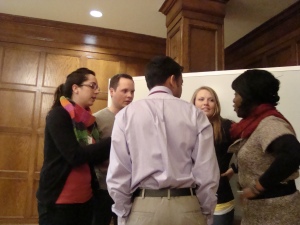This last February, Iowa State University had it’s third annual symposium on sustainability. I attended the student brainstorming session and got to see former ISU GSB vice president Chandra Peterson in action. Her energy and enthusiasm give me hope for the future!
A wonderfully diverse group of students came up with ideas for improving energy usage on campus, educating students and promoting sustainable student lifestyles, reuse of design materials by students, and continuing and improving our food system initiatives of large scale composting and use of locally grown foods.



I never cease to be amazed by the rich diversity found at this university in the middle of the American corn belt. We have a large population of students from China, India, Pakistan and Latin America. How do they wind up in Iowa, a state many US east-coasters can’t even accurately locate?! When I asked an administrator about this once, he replied that word of mouth gets many students here. We have a good university and Ames is a nice sized city of around 50,000. For ISU, these students will bring many of the ideas and world views that we need to create a sustainable future. It is also impressive that our African-American population seems to be growing at ISU. One book I am reading now speaks of the overdeveloped countries, like the U.S. Is it possible to go from overdeveloped, excessive energy use, over-consumption, new technology at any cost, and massive amounts of waste to something more sustainable? It will be to our advantage to have a diverse group of brainstormers in the conversation.













